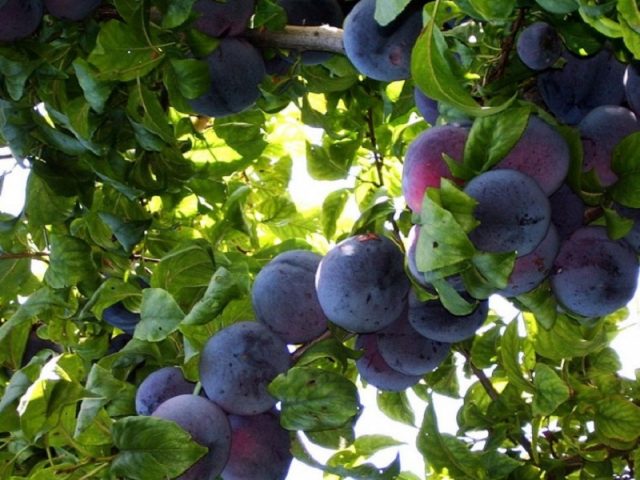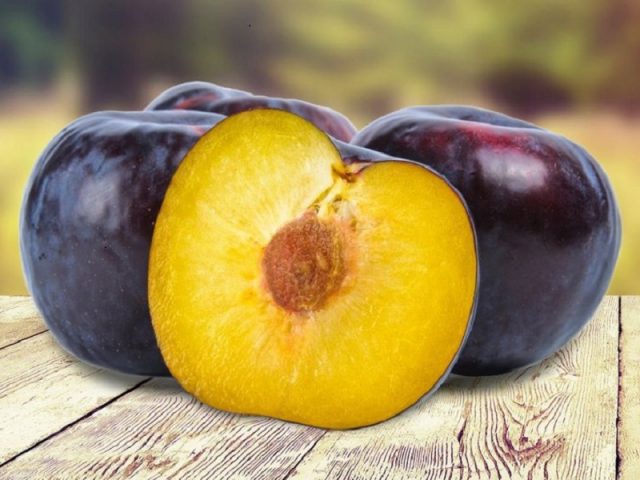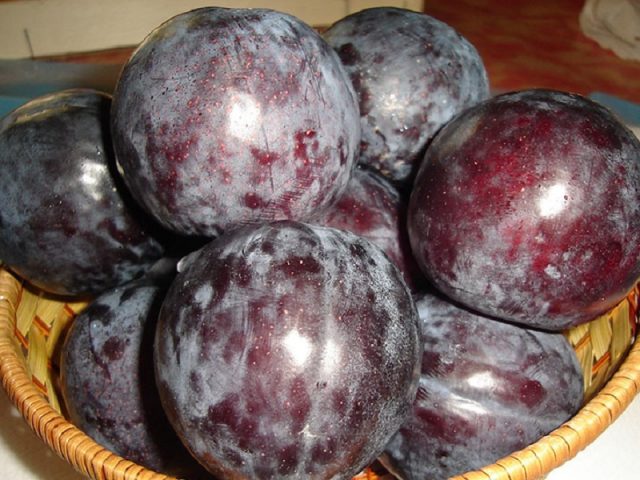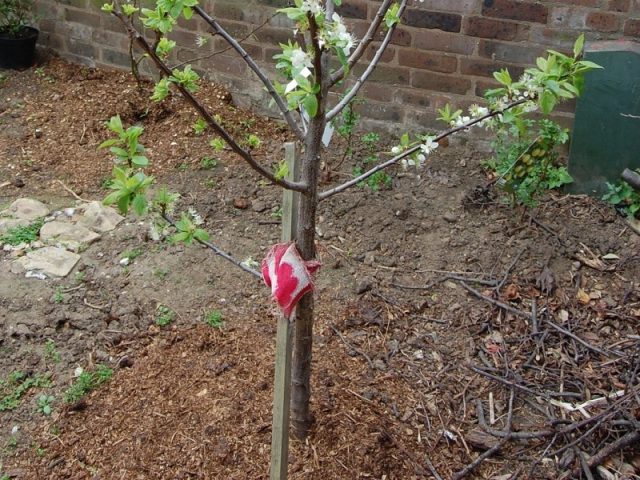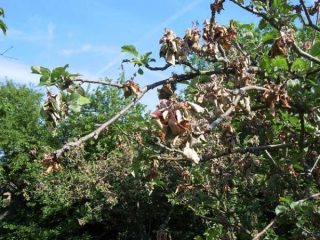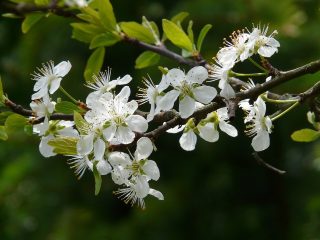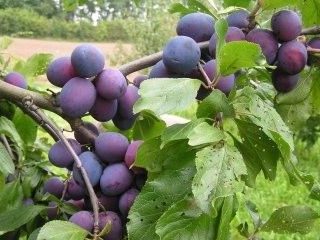Content
Angelina plum is one of the most popular crop varieties that combines a high yield rate, excellent taste and ease of maintenance. Experienced gardeners choose Angelina because they consider her a promising variety.
Breeding history of the variety
Angelina plum bred by Californian breeders. It is a late ripening variety obtained by crossing wild and Chinese plums. Outwardly, the tree resembles a cherry plum, and from the fruit we can conclude that it is a plum. The plum variety Angelina white occupies an intermediate place between the parental forms and belongs to the so-called commercial varieties, due to its versatility and portability.
Description of plum variety
Medium tree with a powerful pyramidal crown. It is characterized by medium density and fast growing branches. The color of the bark and the shape of the leaves are the same as those of the wild plum. But the fruits are distinguished by their size, weighing up to 90 g, and increased juiciness. The pulp is amber, dense, with a sweet and sour aftertaste. Outwardly, the fruit is purple, almost black with a whitish bloom. The seeds are small, difficult to separate from the pulp due to their fibrous and dense structure. It can be refrigerated for more than 4 months and retain its taste and benefits.
Variety characteristics
Angelina White Plum has many advantages over other varieties. It is distinguished by high yields, good resistance to climate change, diseases and pests, as well as a wide range of applications in various fields of activity. But, like any fruit tree, it has advantages and disadvantages.
More about plum varieties Angelina:
Drought resistance, frost resistance
Compared to other varieties of plums, Angelina is quite resistant to frosty and docile climates. But in order to ensure high-quality fruiting for the next year, it is necessary to prepare the tree for winter, as well as choose the right place for planting it.
Pollinators for plum Angelina
The plum of the Angelina variety is self-fertile and needs pollinators, which can be cherry plum Traveler, Columnar and Plum Black Amber, Ozark Premier. The wild plum varieties that bloom at the same time as Angelina are also excellent pollinators. The flowering period falls in the first half of May, and fruiting begins in September and lasts until October.
Productivity and fruiting
High yield and regular fruiting gives the Angelina plum the right to be among the most promising varieties. Plum is widely used in production in various fields of activity. From one tree, you can collect about 50-80 kg of fruits.
Fruiting occurs every year at the beginning of the third decade of September. After planting, it begins to form a crop already for 4 years.
Scope of berries
The fruits of the plum variety Angelina are used in cooking both fresh and frozen. They are used to make such preparations as jam, compote, prunes, and also used in the preparation of various desserts and sauces. And also fruits have found application in cosmetic and medicinal purposes, as they are rich in vitamins, minerals and other substances important for the vital activity of the body.
Disease and pest resistance
Angelina plum variety is resistant to many fungal diseases, pests, and also adapts well to adverse environmental conditions. The main plant diseases include perforation, rust and fruit rot. If lesions are found on the fruits, it is necessary to urgently take the necessary measures and eliminate the problem. Plum attracts the attention of a wide variety of insects. Dangerous pests are plum sawfly, moth, and reed aphid. It is important to recognize the parasites in time and save the plant.
Advantages and disadvantages of the variety
Like any variety of plums, Angelina has its own individual advantages and disadvantages. The secrets of why this variety of plum conquers gardeners lies in the following qualities:
- size and taste of fruits;
- storage duration;
- increased frost and drought resistance;
- high yield rate;
- the ability to use for various purposes.
The disadvantages of plum varieties Angelina include:
- the ability to catch a disease due to bad weather;
- difficulty in selecting the required pollinator;
- poor likelihood of growing in the Chernozem region.
A number of advantages do eliminate most of the disadvantages of Angelina plum, but the presence of significant breeding problems can affect the quality and quantity of the resulting crop.
Landing features
An important event for each fruit tree, which will further affect its growth and development, is planting. In order to get the maximum amount of harvest with a high taste quality and an attractive appearance of the fruits, it is necessary to familiarize yourself with the basic recommendations for planting Angelina plums.
Recommended timing
Saplings are best purchased in spring or autumn. This time is considered the most favorable for planting due to the high frost resistance of the plant.
Choosing the right place
For planting, choose a large and sunny area, since this light-loving plant grows strongly. The soil should be well fertilized with organic and inorganic substances. This will promote optimal growth and development of the Angelina plum.
What crops can and cannot be planted nearby
Any tall trees will interfere with the active growth of the Angelina plum and protect it from the sun. This can slow down the development of the plant and significantly reduce the yield. Planting an apple, pear, raspberry, black currant nearby will have a negative impact on the culture. Maple is a good neighbor for plums.
Selection and preparation of planting material
When buying Angelina plum saplings, you should pay attention to the root system: it must be carefully wrapped in foil and fertilized with peat, which is necessary for reliable protection against mechanical damage and moisture loss.
How to plant plum Angelina correctly
Planting plum varieties Angelina requires the following actions:
- Dig a planting hole 60 by 70 cm in size. The root system of the seedling should be freely placed in the planting recess without bends and creases in the roots.
- At the bottom of the pit, lay a composition of organic matter and mineral elements, mixed with fertile soil.
- In the hole in the center, form a hill and put a peg, which will serve as a support for the seedling.
- Place the plant to the north of the peg, gently spreading the roots and sprinkle with earth.
- It is good to compact and water the earth.
- After the moisture has been absorbed, mulch with sawdust.
- At the end of the planting process, securely tie the seedling to the peg.
Plum follow-up care
Growing Angelina plums requires some attention and care. From the very beginning, the tree begins to need proper pruning, which should stimulate active growth of branches and the formation of a perfect crown. And also it is systematically necessary to carry out sanitary pruning to get rid of damaged or diseased or pest-affected plant areas.
Fruiting weakens the tree as much as possible and leads to early death. To avoid this, it is recommended to regularly water, if necessary, and fertilize with organic and mineral compounds at intervals of 2-3 times a year.
In order to qualitatively prepare the Angelina plum for the cold weather, you need:
- tamp the soil around the tree;
- water and fertilize abundantly;
- paint the trunk with lime;
- mulch with humus.
After the snow falls, it is recommended to form a small snowdrift around the tree.
Diseases and pests, methods of control and prevention
Despite the high resistance to weather changes and undemanding care, the plum of the Angelina variety, due to damage by various diseases or pests, can lose its long-awaited harvest. To avoid this, you should be familiar with the prevention and treatment of these diseases.
| Disease | Symptoms | Prophylaxis | Treatment |
| Rust | The formation of brown spots with a rusty tinge between the veins of the leaves. By the fall, they become darker. | Treat the seeds with fungicides before planting or make layers exclusively from healthy trees, feed the plant with microelements. | Use fungicides, apply them to problem areas. |
| Fruit rot | Formation of a dark spot on the fruit that gradually spreads to the entire fruit. | Avoid mechanical damage to the fruit, spray every 3 days with iodine solution. | Collect and incinerate affected parts. |
| Chlorotic annular spot | Yellow rings and stripes on the leaf. Dark spots on fruits. | Clean up weeds and use healthy material for planting. | Disinfection should be carried out only in special laboratory conditions. |
Pest
| Pest | Prophylaxis | Mary struggle |
| Plum sawfly | Loosen the soil, water abundantly during flowering. | Burn damaged parts of the plant. |
| Plum moth | Timely clean the area from fallen plums and loosen the soil. | To clear the tree of extinct bark and shake off the mutilated fruits, use a chemical sprayer. |
| Reed aphid | Remove weeds and water regularly. | Spray the crown with pyrethroids, mineral oils or insecticides containing nicotine. |
Timely elimination of the problem that has arisen will have a positive effect on the quality and quantity of the crop.
Conclusion
Plum Angelina will certainly thank you for proper care and care with the highest yield, excellent taste and attractive appearance. Many experienced gardeners purchase this particular variety because they are convinced of its productivity.
